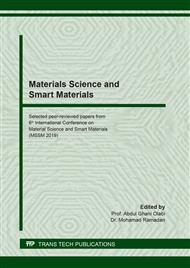[1]
A.A. Fotiev, B.V. Slobodin, M.Ya. Hodos, Vanadaty. Sostav, sintez, struktura, svoystva [Vanadates. Composition, synthesis, structure, properties], Moscow, Nauka, 1988 (in Russian).
Google Scholar
[2]
L.G. Chumilina, Thermochemical properties of oxide compounds based on elements of group III of the periodic system of D.I. Mendeleyev: Dissertation (Institute of Metallurgy of Ural Branch of RAS, Krasnoyarsk, Russian Federation) (2016) 148 p. www.imet-uran.ru/emp/Chumilina /info.htm (accessed on 31 May 2019) (in Russian).
Google Scholar
[3]
X.T. Wei, J. Wen, Sh. Li, Sh. Huang, J. Cheng, Y.H. Chen, Ch.K. Duan, M. Yin, Red-shift of vanadate band-gap by cation substitution for application in phosphor-converted white light-emitting diodes, Appl. Phys. Lett. 104 (2014) 181904-4.
DOI: 10.1063/1.4875926
Google Scholar
[4]
A.I. Zagumennyi, P.A. Popov, F. Zerouk, Yu.D. Zavartsev, S.A. Kutovoi, I.A. Shcherbakov, Heat conduction of laser vanadate crystals, Quantum Electron+ 38 (2008) 227-232.
DOI: 10.1070/qe2008v038n03abeh013699
Google Scholar
[5]
A.I. Zagumennyi, S.A. Kutovoi, A.A. Sirotkin, A.A. Kutovoi, V.I. Vlasov, I.D. Iskhakova, Y.D. Zavartsev, W. Luthy, T. Feurer, Spectroscopy and lasing of new mixed Nd-doped (Sc,Y)VO4 crystals, Appl. Phys. B-Lasers O. 99 (2010) 159-162.
DOI: 10.1007/s00340-009-3841-0
Google Scholar
[6]
H. Cong, H. Zhang, B. Yao, W. Yu, X. Zhao, J. Wang, G. Zhang, ScVO4: Explorations of Novel Crystalline Inorganic Optical Materials in Rare-Earth Orthovanadate Systems, Cryst. Growth Des. 10 (2010) 4389-4400.
DOI: 10.1021/cg1004962
Google Scholar
[7]
X. Ye, D. Wu, M. Yang, Q. Li, X. Huang, Y. Yang, H. Nie, Luminescence Properties of Fine-Grained ScVO4:Eu3+ and Sc0.93-xLnxVO4:Eu3+0.07 (Ln = Y,La,Gd,Lu) Phosphors, ECS J. Solid State Sc. 3 (2014) R95-R99.
DOI: 10.1149/2.007406jss
Google Scholar
[8]
V.S. Urusov, Energetic theory of miscibility gaps in mineral solid solutions, Fortschr. Mineral. 52 (1975) 141-150.
Google Scholar
[9]
E.I. Get'man, A.V. Ignatov, V.V. Prisedsky, K.V. Borysova, Complete and limited substitution of rare-earth elements in apatite silicates La(9-x)Lnx(SiO4)6O1.5, Solid State Sci. 76 (2018) 8-14.
DOI: 10.1016/j.solidstatesciences.2017.12.001
Google Scholar
[10]
D.H. Templeton, Madelung Constants and Coordination, J. Chem. Phys. 21 (1953) 2097-2098.
Google Scholar
[11]
K. Li, D. Xue, Estimation of Electronegativity Values of Elements in Different Valence States, J. Phys. Chem. A 110 (2006) 11332-11337.
DOI: 10.1021/jp062886k
Google Scholar
[12]
S.S. Batsanov, Strukturnaya khimiya. Fakty i zavisimosti [Structural chemistry. Facts and dependencies], Moscow, Dialog-MSU, 2000 (in Russian).
Google Scholar
[13]
S.S. Batsanov, The Concept of Electronegativity. Conclusions and Prospects, Russ. Chem. Rev. 37 (1968) 332-351.
DOI: 10.1070/rc1968v037n05abeh001639
Google Scholar
[14]
E.I. Get'man, Izomorfnye zameshcheniia v volframatnyh i molybdatnyh sistemah [Isomorphous Substitutions in Tungstate and Molybdate Systems], Novosibirsk, Nauka, 1985 (in Russian).
Google Scholar
[15]
R. Becker, Über den Aufbau binarer Legierungen (On the constitution of binary alloys), Z. Metallkd. 29 (1937) 245-249. (in German).
Google Scholar
[16]
E.I. Get'man, S.V. Radio, L.B. Ignatova, L.I. Ardanova, Energies of Mixing (Interaction Parameters), Substitution Limits, and Phase Stability of Solid Solutions Lu1 – xLnxVO4 (Ln = Ce–Yb, Sc, Y), Russ. J. Inorg. Chem. 64 (2019) 118–124.
DOI: 10.1134/s0036023619010091
Google Scholar
[17]
F. Kang, M. Peng, X. Yang, G. Dong, G. Nie, W. Liang, Sh. Xu, J. Qiu, Broadly tuning Bi3+ emission via crystal field modulation in solid solution compounds (Y,Lu,Sc)VO4:Bi for ultraviolet converted white LEDs, J. Mater. Chem. C, 2 (2014) 6068-6076.
DOI: 10.1039/c4tc00238e
Google Scholar
[18]
R.J. Lundgren, L.M.D. Cranswick, M. Bieringer, Phase Stability, Structural Evolution and Magnetic Properties of Sc(1–x)LuxVO3 (0.0<x<1.0), Chem. Mater. 19 (2007) 3945.
DOI: 10.1002/chin.200742020
Google Scholar
[19]
F. Chi, Y. Qin, F. Hu, X. Wei, Y. Chen, Ch. Duan, M. Yin, Efficient red-emitting phosphor ScVO4 doped with Bi3+ and Eu3+ for near-ultraviolet-activated solid-state lighting, J. Mater. Sci. 52 (2017) 11592-11597.
DOI: 10.1007/s10853-017-1329-6
Google Scholar


